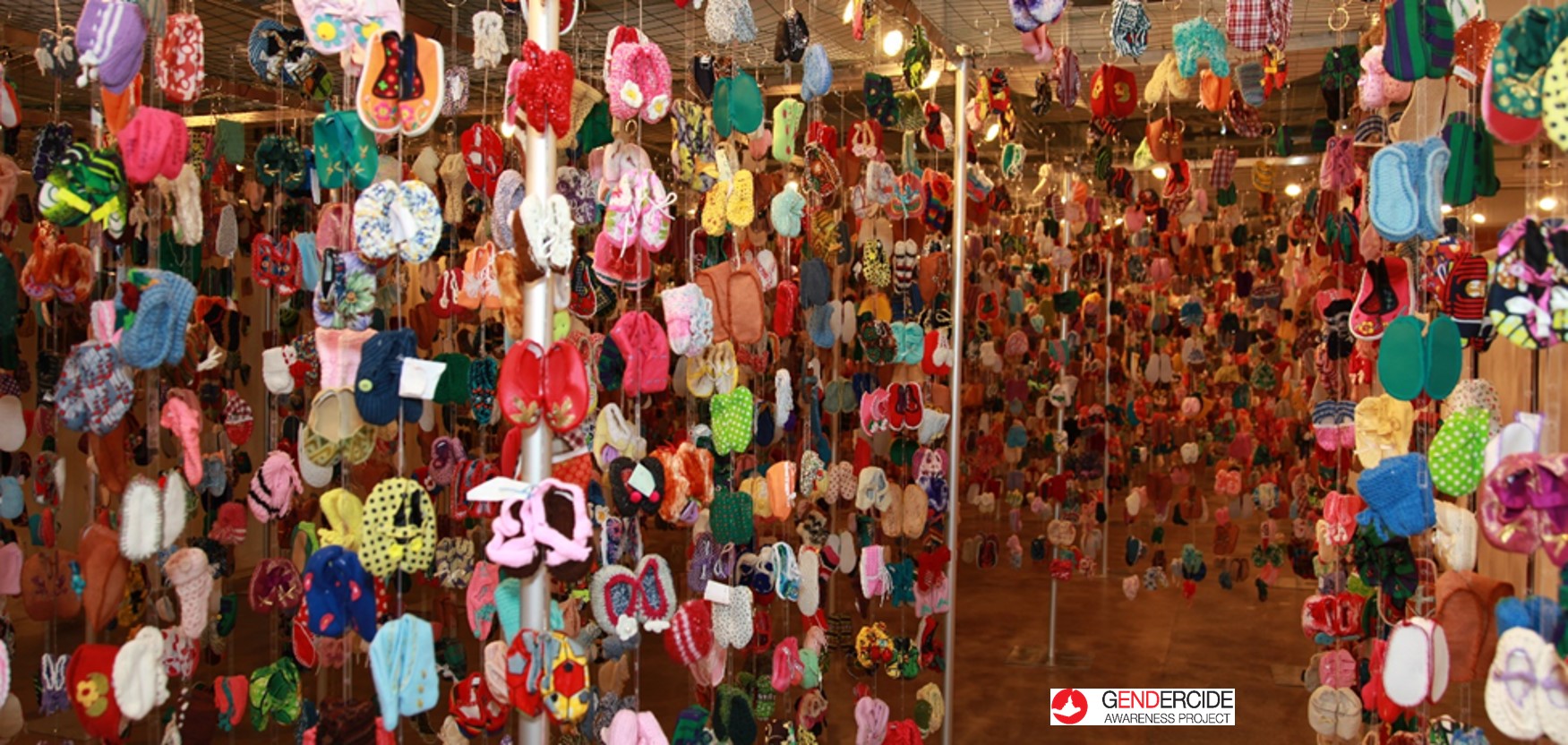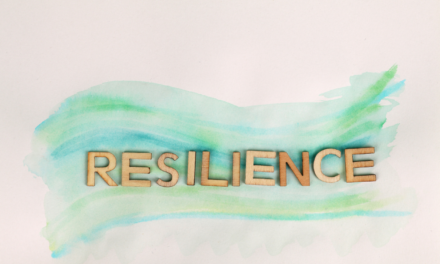How do you give voice to 126 million women who are missing?
First, let me clarify what I mean by “missing.” These women are not missing because they were trafficked or abducted – that accounts for just a small percentage. Nor are they missing because they failed to come home one night. No, these women are demographically missing, meaning that the world population does not contain as many females as it should. Stated bluntly, they are dead. 126 million females have perished due to severe discrimination and lack of the most basic human rights. They failed to survive due to social causes – due to human choice and human behavior.
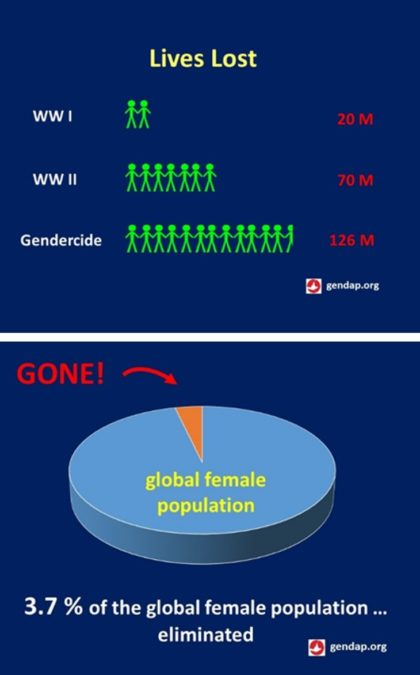 What? Female genocide, commonly called “gendercide,” is one of the world’s best kept secrets, rarely appearing in the news. For many years we’ve known that, in parts of the world, oppression makes women’s lives extremely difficult. It was only in 1990, when Nobel-Prize winning economist Amartya Sen published a study in the New York Review of Books, that we understood that such oppression is lethal – to the point that it makes a measurable dent in the human population. Oppression, it turns out, has caused 3.7% of the world’s female population to vanish! That’s a staggering figure. How do we calculate this? And how do we know that these females are dead due to social causes rather than natural causes? The methodology is quite simple. Demographers identify countries with well-known traditions of severe discrimination against women. They divide the population of each country into age brackets, and using census data, determine the sex ratio for each bracket. They then compare these sex ratios, age bracket by age bracket, with those of socio-economically similar countries that do not practice severe discrimination – countries that serve as the norm. It’s easy to see what the sex ratios ought to be, bracket by bracket, in affected countries, and to calculate how many females are missing from each bracket. In essence, demographers measure female mortality in excess of the norm. Migration data, which can favor one sex over the other, is factored in, and cross-checks are performed against earlier censuses, birth records, and mortality records (when possible).
What? Female genocide, commonly called “gendercide,” is one of the world’s best kept secrets, rarely appearing in the news. For many years we’ve known that, in parts of the world, oppression makes women’s lives extremely difficult. It was only in 1990, when Nobel-Prize winning economist Amartya Sen published a study in the New York Review of Books, that we understood that such oppression is lethal – to the point that it makes a measurable dent in the human population. Oppression, it turns out, has caused 3.7% of the world’s female population to vanish! That’s a staggering figure. How do we calculate this? And how do we know that these females are dead due to social causes rather than natural causes? The methodology is quite simple. Demographers identify countries with well-known traditions of severe discrimination against women. They divide the population of each country into age brackets, and using census data, determine the sex ratio for each bracket. They then compare these sex ratios, age bracket by age bracket, with those of socio-economically similar countries that do not practice severe discrimination – countries that serve as the norm. It’s easy to see what the sex ratios ought to be, bracket by bracket, in affected countries, and to calculate how many females are missing from each bracket. In essence, demographers measure female mortality in excess of the norm. Migration data, which can favor one sex over the other, is factored in, and cross-checks are performed against earlier censuses, birth records, and mortality records (when possible).
The number of lives lost to gendercide is greater than the number of lives lost in World War I and World War II combined, yet the atrocity passes almost unnoticed. In scale, it is rivaled only by the Native American genocide.
We lose females at every stage in the human life span – from before birth through old age. Each year we lose 3.5 million females. The direct causes are:
- sex-selective abortion
- female infanticide
- gross neglect of very young girls
- maternal death that is preventable
- inability of older women, particularly widows, to access food and shelter
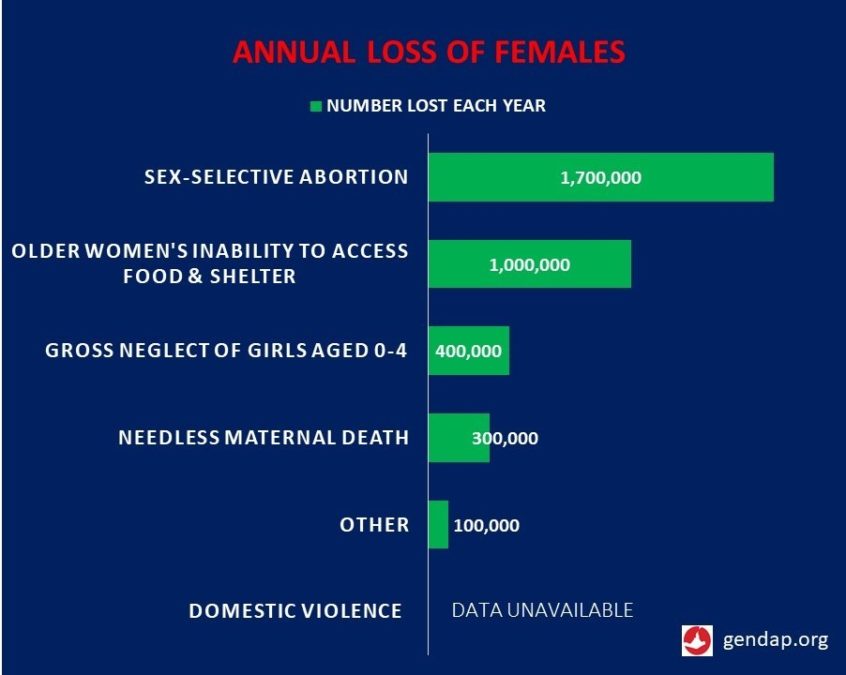 The loss of females is so severe that regions of the world with severely skewed sex ratios have experienced sharp increases in sex trafficking, bride trafficking, crime, and sex crime.
The loss of females is so severe that regions of the world with severely skewed sex ratios have experienced sharp increases in sex trafficking, bride trafficking, crime, and sex crime.
Gendercide passes under the radar because it does not occur in a sudden, headline-grabbing explosion of visible violence. Rather, gendercide occurs regularly in the privacy of the home against a victim who is almost voiceless. From a reporter’s point of view, it is quotidian violence — background noise. From my point of view, it is an atrocity screaming for attention.
How do we bring attention to gendercide?
Design: The Gendercide Awareness Project, a 501(c)(3) nonprofit organization based in Dallas, created a moving and visually powerful art exhibit to demonstrate the scale of gendercide. Thousands of baby booties form a floor-to-ceiling maze, with each pair representing 10,000 missing women and girls. The maze fills almost 2,000 square feet. The exhibit opened in the Dallas Arts District in February 2017 after a soft opening at Austin College in 2016.
As visitors pass through the maze, the density increases, and the passage narrows, blocking visibility and creating an uncomfortable claustrophobic effect. The voices of women and girls, in many languages, are heard intermittently – talking, laughing, singing, chanting. The baby booties, so beautiful and whimsical at the beginning, assume a terrible significance. The visceral impact of the exhibit can be appreciated in this 90-sec video.
Design that empowers: We worked with 40 sewing cooperatives in 30 developing countries to acquire 90% of the baby booties. By paying at-risk women a fair wage to make the booties, we touched the lives of 500 women, enabling them to provide over 20,000 nourishing individual meals for family members. This was work they could do at home while fulfilling their traditional responsibilities of caring for children and elderly parents. We know that when a woman contributes to the family income, as these women did, she gains status and a say in decisions.
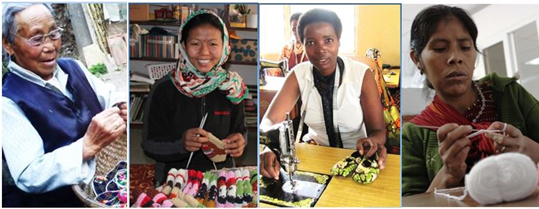
Many of the booties were made by women and girls in extreme circumstances. We worked with cooperatives created for trafficked women, Dalit (Untouchable) women, refugee women, and women with AIDS. The opportunity to work with dignity through sewing and knitting was of incalculable value for these women. We asked them, if possible, to make the baby booties with materials traditional to their own cultures. Consequently, many booties reflect the artisanal traditions of the women who made them.
Significantly, students from Dallas area high schools also contributed baby booties, as did knitters in the US and other developed countries.
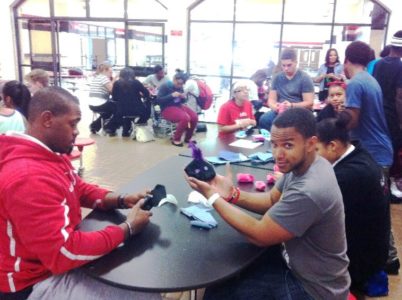
Students from Cedar Hills High School – 2014
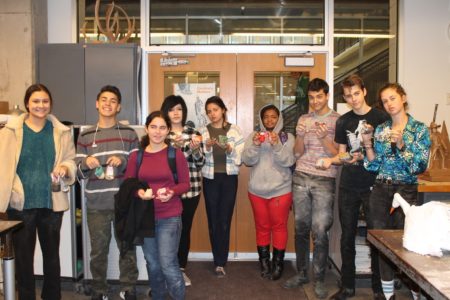
Students from the Booker T. Washington School for the Performing and Visual Arts – 2013
Context: The women’s gentle handiwork responds poignantly to the brutality of gendercide. We situate our exhibit in the “art of conscience” genre — in the tradition of Cleve Jones’ AIDS Memorial Quilt, Ai Weiwei’s Remembering installation, and Naomi Natale’s One Million Bones. We also draw inspiration from the world’s museums of conscience – from the shoes in the Holocaust Memorial Museum (Washington DC), the nooses in the Apartheid Museum (Johannesburg), the mirrored candles in the Yad Vashem Holocaust History Museum (Jerusalem), and the lightless tower in the Jewish Museum (Berlin).
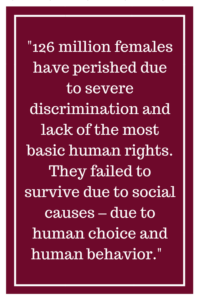 Because such art can be depressing, the challenge is to present a path from hopelessness to hope. That consideration determined our choice of medium – the baby booties are beautiful, whimsical, playful, riotously colorful, and as individualized as the missing women and girls they represent. Video testimonials (80 secs) show that visitors exited the exhibit struck by the beauty that women bring to the world — and wanting to protect that half of the human race. That is a very positive response – one that makes people want to take action.
Because such art can be depressing, the challenge is to present a path from hopelessness to hope. That consideration determined our choice of medium – the baby booties are beautiful, whimsical, playful, riotously colorful, and as individualized as the missing women and girls they represent. Video testimonials (80 secs) show that visitors exited the exhibit struck by the beauty that women bring to the world — and wanting to protect that half of the human race. That is a very positive response – one that makes people want to take action.
Call to Action: We no longer pay women to sew baby booties, as we have all we need. Instead, we use their collective handiwork — the installation — to raise money to educate at-risk girls in developing countries. We believe that girls’ education is the best long-term strategy to end gendercide. In a beautiful arc of giving, the women who made the baby booties are, knowingly or unknowingly, educating a new generation of girls so that they do not have to be at risk.
From Texas to the World: Our exhibit travels to Toronto for the Parliament of the World’s Religions 2018 in November, and later that same month, to United Nations Headquarters in New York City. There it will open on November 26 to mark the International Day for Elimination of Violence against Women and stay up through mid-January. The art exhibit is a global collaboration, created by women who are vulnerable to gendercide. We believe in the power of art to educate, force change, and secure basic rights for women around the world.
Other articles you may be interested in:
- A New Way for Women to Support Each Other: Social Media by Dr. Anne Litwin
- Coloring Inside The Box by Jude Olson
- Rethinking Our Villages by Beverly Hill
- Less Media and More Compassion by Ami Evans

